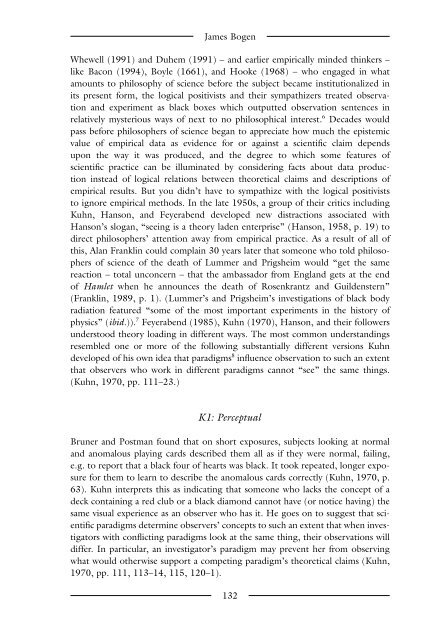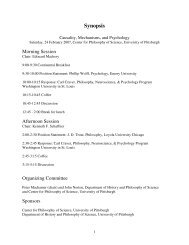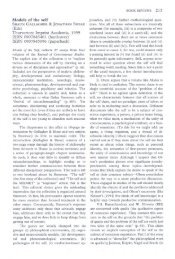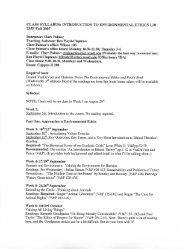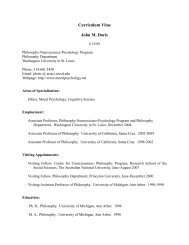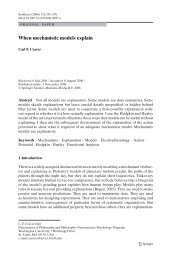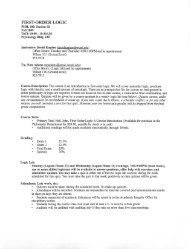The Blackwell Guide to the Philosophy of Science - The Department ...
The Blackwell Guide to the Philosophy of Science - The Department ...
The Blackwell Guide to the Philosophy of Science - The Department ...
Create successful ePaper yourself
Turn your PDF publications into a flip-book with our unique Google optimized e-Paper software.
James Bogen<br />
Whewell (1991) and Duhem (1991) – and earlier empirically minded thinkers –<br />
like Bacon (1994), Boyle (1661), and Hooke (1968) – who engaged in what<br />
amounts <strong>to</strong> philosophy <strong>of</strong> science before <strong>the</strong> subject became institutionalized in<br />
its present form, <strong>the</strong> logical positivists and <strong>the</strong>ir sympathizers treated observation<br />
and experiment as black boxes which outputted observation sentences in<br />
relatively mysterious ways <strong>of</strong> next <strong>to</strong> no philosophical interest. 6 Decades would<br />
pass before philosophers <strong>of</strong> science began <strong>to</strong> appreciate how much <strong>the</strong> epistemic<br />
value <strong>of</strong> empirical data as evidence for or against a scientific claim depends<br />
upon <strong>the</strong> way it was produced, and <strong>the</strong> degree <strong>to</strong> which some features <strong>of</strong><br />
scientific practice can be illuminated by considering facts about data production<br />
instead <strong>of</strong> logical relations between <strong>the</strong>oretical claims and descriptions <strong>of</strong><br />
empirical results. But you didn’t have <strong>to</strong> sympathize with <strong>the</strong> logical positivists<br />
<strong>to</strong> ignore empirical methods. In <strong>the</strong> late 1950s, a group <strong>of</strong> <strong>the</strong>ir critics including<br />
Kuhn, Hanson, and Feyerabend developed new distractions associated with<br />
Hanson’s slogan, “seeing is a <strong>the</strong>ory laden enterprise” (Hanson, 1958, p. 19) <strong>to</strong><br />
direct philosophers’ attention away from empirical practice. As a result <strong>of</strong> all <strong>of</strong><br />
this, Alan Franklin could complain 30 years later that someone who <strong>to</strong>ld philosophers<br />
<strong>of</strong> science <strong>of</strong> <strong>the</strong> death <strong>of</strong> Lummer and Prigsheim would “get <strong>the</strong> same<br />
reaction – <strong>to</strong>tal unconcern – that <strong>the</strong> ambassador from England gets at <strong>the</strong> end<br />
<strong>of</strong> Hamlet when he announces <strong>the</strong> death <strong>of</strong> Rosenkrantz and Guildenstern”<br />
(Franklin, 1989, p. 1). (Lummer’s and Prigsheim’s investigations <strong>of</strong> black body<br />
radiation featured “some <strong>of</strong> <strong>the</strong> most important experiments in <strong>the</strong> his<strong>to</strong>ry <strong>of</strong><br />
physics” (ibid.)). 7 Feyerabend (1985), Kuhn (1970), Hanson, and <strong>the</strong>ir followers<br />
unders<strong>to</strong>od <strong>the</strong>ory loading in different ways. <strong>The</strong> most common understandings<br />
resembled one or more <strong>of</strong> <strong>the</strong> following substantially different versions Kuhn<br />
developed <strong>of</strong> his own idea that paradigms 8 influence observation <strong>to</strong> such an extent<br />
that observers who work in different paradigms cannot “see” <strong>the</strong> same things.<br />
(Kuhn, 1970, pp. 111–23.)<br />
K1: Perceptual<br />
Bruner and Postman found that on short exposures, subjects looking at normal<br />
and anomalous playing cards described <strong>the</strong>m all as if <strong>the</strong>y were normal, failing,<br />
e.g. <strong>to</strong> report that a black four <strong>of</strong> hearts was black. It <strong>to</strong>ok repeated, longer exposure<br />
for <strong>the</strong>m <strong>to</strong> learn <strong>to</strong> describe <strong>the</strong> anomalous cards correctly (Kuhn, 1970, p.<br />
63). Kuhn interprets this as indicating that someone who lacks <strong>the</strong> concept <strong>of</strong> a<br />
deck containing a red club or a black diamond cannot have (or notice having) <strong>the</strong><br />
same visual experience as an observer who has it. He goes on <strong>to</strong> suggest that scientific<br />
paradigms determine observers’ concepts <strong>to</strong> such an extent that when investiga<strong>to</strong>rs<br />
with conflicting paradigms look at <strong>the</strong> same thing, <strong>the</strong>ir observations will<br />
differ. In particular, an investiga<strong>to</strong>r’s paradigm may prevent her from observing<br />
what would o<strong>the</strong>rwise support a competing paradigm’s <strong>the</strong>oretical claims (Kuhn,<br />
1970, pp. 111, 113–14, 115, 120–1).<br />
132


